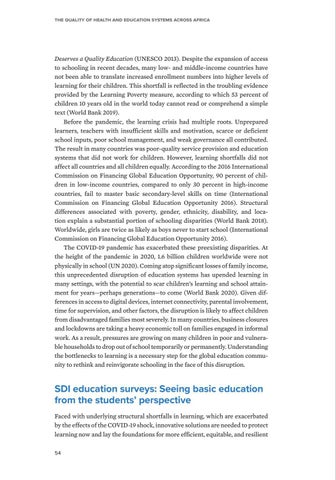The Quality of Health and Education Systems Across Africa
Deserves a Quality Education (UNESCO 2013). Despite the expansion of access to schooling in recent decades, many low- and middle-income countries have not been able to translate increased enrollment numbers into higher levels of learning for their children. This shortfall is reflected in the troubling evidence provided by the Learning Poverty measure, according to which 53 percent of children 10 years old in the world today cannot read or comprehend a simple text (World Bank 2019). Before the pandemic, the learning crisis had multiple roots. Unprepared learners, teachers with insufficient skills and motivation, scarce or deficient school inputs, poor school management, and weak governance all contributed. The result in many countries was poor-quality service provision and education systems that did not work for children. However, learning shortfalls did not affect all countries and all children equally. According to the 2016 International Commission on Financing Global Education Opportunity, 90 percent of children in low-income countries, compared to only 30 percent in high-income countries, fail to master basic secondary-level skills on time (International Commission on Financing Global Education Opportunity 2016). Structural differences associated with poverty, gender, ethnicity, disability, and location explain a substantial portion of schooling disparities (World Bank 2018). Worldwide, girls are twice as likely as boys never to start school (International Commission on Financing Global Education Opportunity 2016). The COVID-19 pandemic has exacerbated these preexisting disparities. At the height of the pandemic in 2020, 1.6 billion children worldwide were not physically in school (UN 2020). Coming atop significant losses of family income, this unprecedented disruption of education systems has upended learning in many settings, with the potential to scar children’s learning and school attainment for years—perhaps generations—to come (World Bank 2020). Given differences in access to digital devices, internet connectivity, parental involvement, time for supervision, and other factors, the disruption is likely to affect children from disadvantaged families most severely. In many countries, business closures and lockdowns are taking a heavy economic toll on families engaged in informal work. As a result, pressures are growing on many children in poor and vulnerable households to drop out of school temporarily or permanently. Understanding the bottlenecks to learning is a necessary step for the global education community to rethink and reinvigorate schooling in the face of this disruption.
SDI education surveys: Seeing basic education from the students’ perspective Faced with underlying structural shortfalls in learning, which are exacerbated by the effects of the COVID-19 shock, innovative solutions are needed to protect learning now and lay the foundations for more efficient, equitable, and resilient 54


